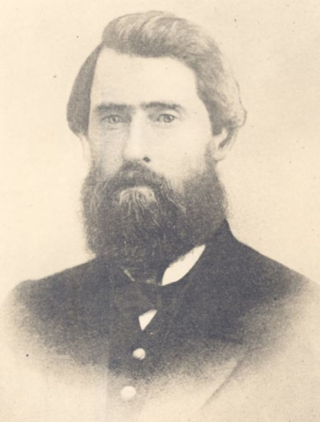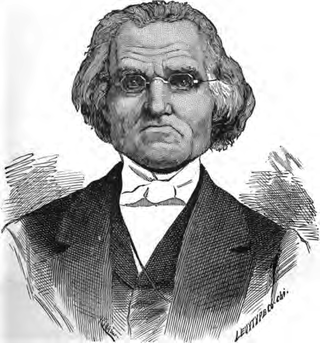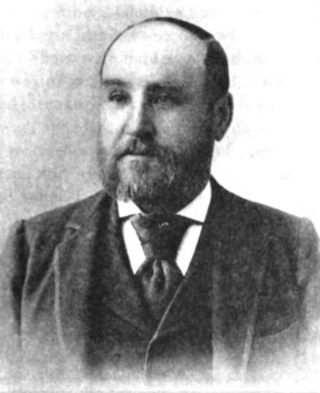Related Research Articles
The Nisqually are a Lushootseed-speaking Native American tribe in western Washington state in the United States. They are a Southern Coast Salish people. They are federally recognized as the Nisqually Indian Tribe, formerly known as the Nisqually Indian Tribe of the Nisqually Reservation and the Confederated Tribes of the Chehalis Reservation.

Jason Lee was a Canadian Methodist Episcopalian missionary and pioneer in the Pacific Northwest. He was born on a farm near Stanstead, Quebec.

Joseph Lafayette Meek was an American pioneer, mountain man, law enforcement official, and politician in the Oregon Country and later Oregon Territory of the United States. A trapper involved in the fur trade before settling in the Tualatin Valley, Meek played a prominent role at the Champoeg Meetings of 1843, where he was elected a sheriff. He was later elected to and served in the Provisional Legislature of Oregon before being appointed as the United States Marshal for the Oregon Territory.

The Archdiocese of Portland in Oregon is a Latin Church archdiocese of the Catholic Church in western Oregon in the United States.

Fort Nisqually was an important fur trading and farming post of the Hudson's Bay Company in the Puget Sound area, part of the Hudson's Bay Company's Columbia Department. It was located in what is now DuPont, Washington. Today it is a living history museum located in Tacoma, Washington, USA, within the boundaries of Point Defiance Park. The Fort Nisqually Granary, moved along with the Factor's House from the original site of the second fort to this park, is a U.S. National Historic Landmark. Built in 1843, the granary is the oldest building in Washington state and one of the only surviving examples of a Hudson's Bay Company "post-and-plank" structure. The Factor's House and the granary are the only surviving Hudson's Bay Company buildings in the United States.

François Norbert Blanchet was a French Canadian-born missionary priest and prelate of the Catholic Church who was instrumental in establishing the Catholic Church presence in the Pacific Northwest. He was one of the first Catholic priests to arrive in what was then known as the Oregon Country and subsequently became the first bishop and archbishop of the Archdiocese of Oregon City.
Naches Pass is a mountain pass in the Cascade Range in the state of Washington. It is located about 50 miles (80 km) east of Tacoma and about 50 miles (80 km) northwest of Yakima, near the headwaters of tributary streams of the Naches River on the east and the Greenwater River on the west. The boundaries of Pierce, King, Kittitas, and Yakima counties come together at the pass. The pass lies on the boundary between the Mount Baker-Snoqualmie and Wenatchee National Forests, about 10 miles (16 km) northeast of Mount Rainier National Park. There are no roadways or railways crossing the pass.

The Champoeg Meetings were the first attempts at formal governance by European-American and French Canadian pioneers in the Oregon Country on the Pacific Northwest coast of North America. Between 1841 and 1843, a series of public councils was held at Champoeg, a settlement on the French Prairie of the Willamette River valley in present-day Marion County, Oregon, and at surrounding settlements. The meetings were organized by newly arrived settlers as well as Protestant missionaries from the Methodist Mission and Catholic Jesuit priests from Canada.
The Puget Sound Agricultural Company (PSAC), with common variations of the name including Puget Sound or Puget's Sound, was a subsidiary joint stock company formed in 1840 by the Hudson's Bay Company (HBC). Its stations operated within the Pacific Northwest, in the HBC administrative division of the Columbia Department. The RAC-HBC Agreement was signed in 1839 between the Russian-American Company and the HBC, with the British to now supply the various trade posts of Russian America. It was hoped by the HBC governing committee that independent American merchants, previously a major source of foodstuffs for the RAC, would be shut out of the Russian markets and leave the Maritime fur trade.
The Methodist Mission was the Methodist Episcopal Church's 19th-century conversion efforts in the Pacific Northwest. Local Indigenous cultures were introduced to western culture and Christianity. Superintendent Jason Lee was the principal leader for almost a decade. It was a political and religious effort. Two years after the mission began, the church's Board of Foreign Missions described its intent to reclaim "these wandering savages, who are in a very degraded state, to the blessings of Christianity and civilized life." Alongside the missions founded in the region were several secular operations opened. These were maintained to allow for material independence from the Hudson's Bay Company (HBC), then the preeminent economic entity in the region among European descendants.

David Leslie was an American missionary and pioneer in what became the state of Oregon. A native of New Hampshire, he joined Jason Lee as a missionary at the Methodist Mission in the Oregon Country in 1836. In that region he participated in the early movement to start a government and his home was used for some of these meetings. With the closing of the mission he became a founder of the city of Salem, Oregon, and board member of the Oregon Institute, which later became Willamette University.

The history of Olympia, Washington, includes long-term habitation by Native Americans, charting by a famous English explorer, settlement of the town in the 1840s, the controversial siting of a state college in the 1960s and the ongoing development of arts and culture from a variety of influences.
Dr. Elijah White (1806–1879) was a missionary and agent for the United States government in Oregon Country during the mid-19th century. A trained physician from New York State, he first traveled to Oregon as part of the Methodist Mission in the Willamette Valley. He returned to the region after a falling-out with mission leader Jason Lee as the leader of one of the first large wagon trains across the Oregon Trail and as a sub-Indian agent of the federal government. In Oregon he used his authority to regulate affairs between the Natives and settlers, and even between settlers. White left the region in 1845 as a messenger for the Provisional Government of Oregon to the United States Congress, returning in 1850 before leaving again for California in the early 1860s.

Augustin Magloire Alexandre Blanchet was a French Canadian prelate of the Roman Catholic Church. He served as the first bishop of the now-defunct Diocese of Walla Walla and of the Diocese of Nesqually in present-day Washington.
Fort Cowlitz or Cowlitz Farm was an agricultural operation by the British Puget Sound Agricultural Company (PSAC), a subsidiary of the Hudson's Bay Company (HBC). It was located on the Cowlitz plains, adjacent to the west bank of the Cowlitz River and several miles northeast of modern Toledo, Washington. The farm was begun during spring of 1839, and its produce soon supplied HBC posts in New Caledonia and Columbia Departments. In the RAC-HBC Agreement, the Russian-American Company received at Novo-Arkhangelsk grain and dairy products from the PSAC along with manufactured goods. Fort Cowlitz produced most of the Company wheat quotas, and its fellow PSAC station Fort Nisqually tended most of the sheep and cattle flocks. By the expiration of the agreement in 1850, Cowlitz Farm wasn't able to meet Russian supply demands.
Pierre Chrysologue Pambrun was a French Canadian militia officer and later a fur trader in the service of the Hudson's Bay Company. Pambrun fought against the United States in the War of 1812, in particular the Battle of the Châteauguay. He joined the HBC during a time of turmoil with its competitors, the North West Company. After the Battle of Seven Oaks, he was among those held captive by men employed by the NWC.
The Clatsop Mission was an outpost of the Methodist Mission near modern Astoria, Oregon, United States. Joseph H. Frost and his family was sent to the Clatsop Plains at the mouth of the Columbia River in 1841. Frustrated at his inability to convert the local Clatsop and Nehalem people, Frost took his family and left the area in August 1843. Josiah Parrish was appointed as his replacement, working at the station until its closure the following year in 1844.

Jean-Baptiste-Zacharie Bolduc was a Québécois Jesuit. His career started as a missionary in the Pacific Northwest, where he resided for eight years. Later he worked in the Catholic medical efforts in Québec.
John Plastis Richmond was an American Methodist Episcopalian priest and politician who served in New York, Illinois, Mississippi, the Pacific Northwest, and South Dakota during the 19th century.

Edward Huggins was a Hudson's Bay Company clerk, Pierce County commissioner, Pierce County auditor, and historian of the Northwestern United States. The Fort Nisqually Living History Museum has a collection of items related to Huggins.
References
- ↑ Brosnan 1932, p. 171.
- ↑ Meeker 1905, p. 538.
- 1 2 Brosnan 1932, p. 172.
- ↑ Meeker 1905, p. 510.
- 1 2 Hunt & Kaylor 1917, p. 97.
- ↑ Gatke 1935, p. 82.
- ↑ Blanchet et al. 1956, p. 172.